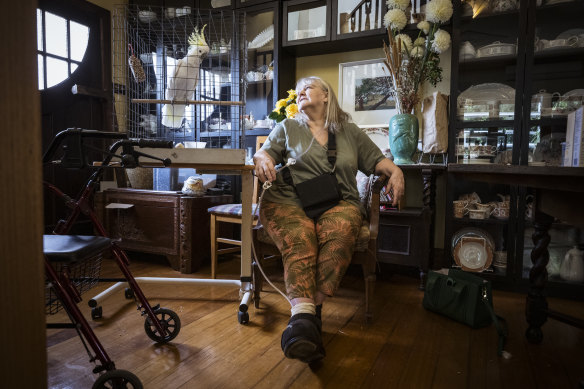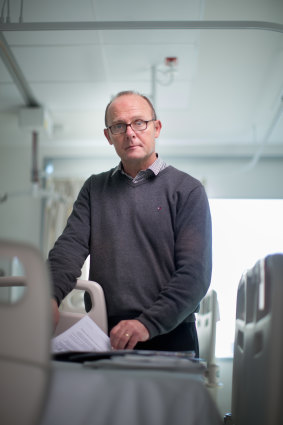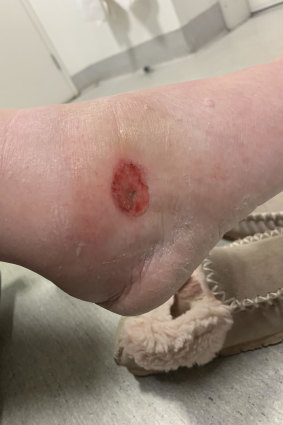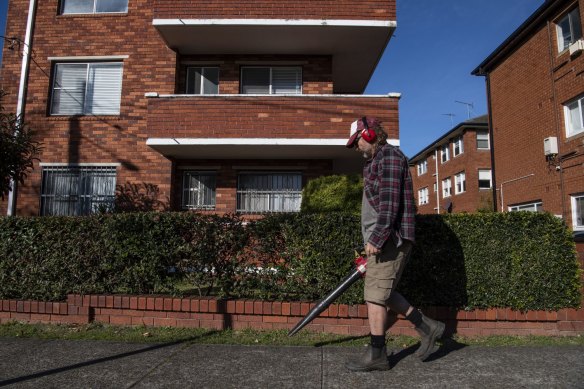By Aisha Dow
People with diabetes and tradies working with soil are at higher risk of developing the Buruli ulcer, a new study suggests, as cases of the flesh-eating disease continue to spread to new areas of Victoria and the country.

Fiona Wordie, who has diabetes, developed a Buruli ulcer in June.Credit: Chris Hopkins
Almost 250 people who have developed the nasty bacterial infection and 481 unaffected people living on either side of Port Phillip Bay were involved in the research, hailed as the largest-ever study into risk factors for the painful ulcer, and the things that can protect against it.
The rate of diabetes among those with the ulcer was two times higher than in the control group (7.8 per cent versus 3.9 per cent).
Buruli ulcer cases also appear to be more common in those who work outdoors with soil in known transmission areas, suggests the research by Barwon Health, Deakin University and the CSIRO, Australia’s national science agency.
Scientists have made a string of recent breakthroughs to better understand how people acquire the exotic disease. They are now confident that ringtail and brushtail possums and mosquitos play a part in spreading Mycobacterium ulcerans, the bacteria that cause the ulcer, to humans.

Infectious diseases expert Daniel O’Brien.Credit: Simon Schluter
However, Associate Professor Daniel O’Brien, the director of infectious diseases at Barwon Health and one of the authors of the latest study, said there was much more work to do and more research investment required, as the ulcer continued to advance into new parts of the country.
There have been 369 cases detected in Victoria over the past 12 months. This year is on track to break a record, with 216 cases detected so far, compared with 185 over the same period in 2022.
The bacterium has also spread from southern coastal areas to inland Melbourne suburbs such as Pascoe Vale, Moonee Ponds, Brunswick West and Essendon, and to Belmont, Newtown and Marshall in Geelong. A locally acquired ulcer was detected in NSW for the first time last month, in Batemans Bay.
“It’s in Geelong, it’s in the Bellarine Peninsula and Mornington Peninsula. It’s on the Surf Coast. It’s been in Gippsland,” O’Brien said.
“We don’t know where it is going to turn up next … every Victorian really needs to be aware of it.”
Coburg retiree Fiona Wordie said her Buruli ulcer began with an itch on her foot one Thursday morning in June this year, and peaked with shooting pain so bad that she said she taught her pet cockatoo to swear.
It now says the “F word”.
“That’s how painful it was. I don’t normally swear but I was hopping around like a lunatic, it was so bad... It was shocking, just shocking. I’m glad I’m past that stage now.”
The 66-year-old said the source of the itch on her foot initially looked a bit like a spider bite, but it grew within days to a hole about 2½ centimetres long, then into a weeping sore that covered half of one side of her foot.

An early-stage Buruli ulcer.
She spent two weeks in hospital and is still having regular debridements (a procedure where dead or infected skin is removed from the ulcer), which have also left her in significant pain.
Wordie has several likely risk factors for the disease. She lives in a part of Melbourne where there have been other cases; she is a type 1 diabetic; a possum lives near the house and leaves droppings in the garden; and she can remember being bitten by a mosquito last year.
O’Brien said the research finding that diabetes could be a risk factor for contracting a Buruli ulcer wasn’t unexpected, as he had noticed in patients he had treated that people whose immune systems were suppressed were more likely to get severe cases. Diabetes can weaken people’s immune systems.
Dr Bridgette McNamara, an epidemiologist with Barwon South West Public Health Unit, said the study also underlined the importance of using protective measures to try to avoid the Buruli ulcer.
These include applying insect repellents, covering your arms and legs outdoors, washing any cuts and wounds immediately and generally washing your hands after being outdoors.

People who work with soil outside could be at higher risk of acquiring the ulcer.Credit: Louise Kennerley
This message is particularly relevant for those working outside who come into contact with soil, she said. Dozens of people who had Buruli ulcers had an occupation that led them to work with soil outside in areas where the ulcer was known to be present, such as gardeners, carpenters and other construction workers.
Wordie said that after months of intensive treatment her ulcer had shrunk down to about seven centimetres long, but she could still need multiple operations.
“I’m glad I didn’t lose my leg, because that’s what went through my mind.”
In an exclusive offer for subscribers, order a copy of Life As We Knew It, the story of Australia’s pandemic by Aisha Dow and Melissa Cunningham, from Scribe for 30 per cent off the retail price. Click here for details. This offer is available until October 31, 2023.